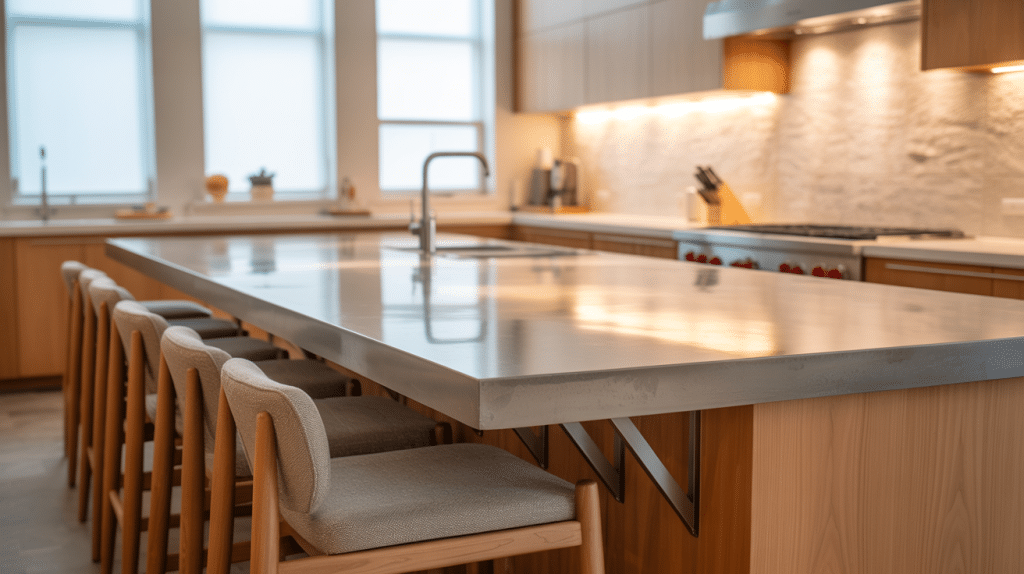I’ve learned the hard way that the wrong kitchen island height can make even the nicest kitchen frustrating to use. Too high, and meal prep feels like a stretch. Too low, and dining feels awkward.
Your island is more than just a countertop; it’s where you cook, eat, help with homework, and gather with friends. Getting the height right makes all those moments easier and more comfortable.
I’ll walk you through the standard kitchen island heights, when each one works best, and how to match them to your daily routine.
By the end, you’ll know exactly which height will fit your kitchen and make it work better for you.
Standard Kitchen Island Heights
Getting the height of your kitchen island right is key for comfort, function, and style.
Most kitchen islands fall into two main height categories. Each serves different purposes and works better for specific activities. Here’s a quick get-to-know for both:
Kitchen Counter Height (36 inches / 91 cm)
This is the most common kitchen countertop height. It matches your regular kitchen counters, creating a smooth flow throughout the space.
Counter height works best for everyday food prep. Chopping vegetables, rolling dough, and mixing ingredients all feel natural at this level.
Many families choose this height for casual dining, too. Kids can easily reach the surface, and it feels comfortable for quick breakfasts or homework time.
Bar Height (40-42 inches / 102-107 cm)
Bar height islands create a more formal dining experience. They work well when you want to separate the cooking area from the eating space.
This height is perfect for entertaining. Guests can sit and chat while you cook without getting in the way of your work.
The extra height also provides more storage space underneath. You can fit taller cabinets or appliances in the base.
Custom Heights
Sometimes standard heights don’t work for your specific needs. Very tall or short family members might need adjustments.
- Lower islands (32-34 inches) work well for bakers who do lots of kneading and rolling. The lower surface gives you better leverage.
- Higher islands (44-46 inches) can work in kitchens with very high ceilings. They help maintain proper proportions in the space.
How to Choose the Right Height
Think about how you actually use your kitchen. Your daily activities should guide your height choice more than design trends. Here are some tips to help you make the best choice:
1. Match Height to Function
Food prep works best at counter height. This puts your work surface at the right level for comfortable cutting and mixing.
If you plan to eat most meals on the island, consider how formal you want the dining to feel. Counter height feels casual, while bar height feels more like a restaurant.
Multi-use islands need careful planning. You might want two different heights on the same island for different activities.
2. Consider Seating and Stools
The right stool height makes sitting at your island comfortable for everyone. Getting this pairing wrong leads to sore backs and awkward meals.
For a 36-inch counter height, use 24-inch stools. This gives you the standard 12-inch clearance between the seat and the surface.
For a 42-inch bar height, use 30-inch stools. The same 12-inch rule applies here, too.
Always test stools before buying. Comfort varies by person, and you want everyone to enjoy sitting at your island.
3. Accessibility and Family Needs
Think about who uses your kitchen most often. If you have young children, counter height lets them help with cooking and reach things easily.
Older adults or people with mobility issues often find counter height more comfortable. It requires less reaching and feels more stable.
ADA guidelines recommend counter heights between 28-34 inches for wheelchair accessibility. Consider this if it applies to your family.
Space Planning Essentials

Space planning plays a big role in how well your kitchen island works. Leave at least 42 inches of clearance on all sides, or 48 inches if there’s seating, and up to 54 inches for busy kitchens.
Plan overhangs to suit your seating,10–12 inches for stools, 15–18 inches for dining chairs, and support any overhang of 12 inches with brackets.
Keep proportions in mind: counter height suits 8-foot ceilings, bar height works better in rooms over 10 feet, and matching the island height to upper cabinets creates a balanced look.
Special Design Considerations for Kitchen
Some kitchens need extra planning to make the island work perfectly. The table below highlights a few creative solutions that improve both function and style:
| Feature | Details | Key Benefits |
|---|---|---|
| Multi-Level Islands | Counter height for prep, bar height for dining; usually a 6-inch difference between levels | Separates cooking and dining areas, ideal for open-plan spaces |
| Appliance Integration | Counter height fits dishwashers and refrigerator drawers; bar height allows wine fridges, taller storage, and microwaves are easier at counter height | Maximizes storage, improves appliance access |
| Lighting Alignment | Pendants 30–36 inches above the surface; same gap for both heights; adjust cords for high ceilings | Provides good visibility, keeps sight lines clear |
With the right design choices, your kitchen island can serve multiple purposes without sacrificing comfort or flow.
Planning these details early ensures your island looks and works exactly how you want.
Common Mistakes to Avoid
Even a well-designed kitchen island can fall short if the height isn’t right. Here are some common mistakes to avoid when planning yours:
- Copying someone else’s island height without considering your own needs; what works for them might not work for you.
- Choosing height based only on appearance instead of focusing on comfort and function.
- Forgetting to account for thick countertops, a 2-inch granite slab can noticeably change the final height.
- Skipping careful measurements, moving plumbing or electrical later is costly and time-consuming
By steering clear of these mistakes, you’ll ensure your kitchen island is both practical and comfortable for everyone who uses it.
Final Thoughts
For me, finding the right kitchen island height has been about making my space work for me every single day. It’s not just numbers on a tape measure—it’s about comfort, flow, and how I actually use my kitchen.
I’ve noticed how the right height changes everything, from prepping dinner to cooking with friends to sharing weekend breakfasts. When it feels right, every moment in the kitchen just works better.
Take a little time to test what feels natural for you and your family. Once you get it right, you’ll enjoy your island more and make the most of the space you have.
If you found this helpful, check out other posts on the website for more tips and ideas to make your home fit your life!





